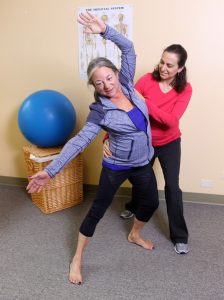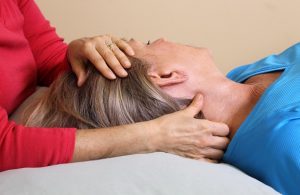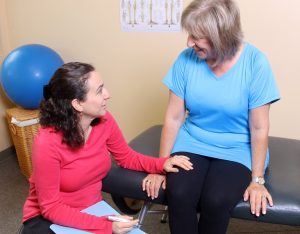Denise’s definition of Physical Therapy (PT):
 Physical Therapists are movement experts working with people of all ages, from infants to the elderly, who understand how the body is supposed to move for any given activity in order to get you back to do doing the things you love. PTs use their highly skilled hands to manipulate tissue to promote healing and improve mobility. PTs prescribe exercises for a patient’s specific needs in order to improve mobility and balance, increase strength, improve coordination, improve body awareness, and improve movement needed for any activity. But above all, PTs are educators, teaching their patients how to manage or abolish their pain, take care of their bodies to prevent further injury or disability, and facilitate their patients to be as independent as possible.
Physical Therapists are movement experts working with people of all ages, from infants to the elderly, who understand how the body is supposed to move for any given activity in order to get you back to do doing the things you love. PTs use their highly skilled hands to manipulate tissue to promote healing and improve mobility. PTs prescribe exercises for a patient’s specific needs in order to improve mobility and balance, increase strength, improve coordination, improve body awareness, and improve movement needed for any activity. But above all, PTs are educators, teaching their patients how to manage or abolish their pain, take care of their bodies to prevent further injury or disability, and facilitate their patients to be as independent as possible.
When I decided to become a PT over 30 years ago, being just shy of 5’ tall, people looked at me and said “you are so small; how are you going to be able to lift people?” I repeatedly had to explain to people what PT is and how my size didn’t matter. I learned how to use my body safely to help others and prevent injury to myself, whether I have to help someone stand from a chair, hold someone’s leg for exercise, or use my hands to manipulate soft tissue and joints. In fact, I’ve now been a PT for over 25 years and have never had a work related injury!
Over the years I have heard many misnomers about physical therapy and appropriately some of the statements directly correlated to my work; other statements were just a misinformed observation on the other person’s part. I’ve compiled some comments or myths about PT people have said to me over the years:
11 Myths and Misunderstandings About Physical Therapy
- PT stands for “pain and torture” or “physical terrorists”
Contrary to belief, PT is not supposed to be painful or cause further injury. Oftentimes, the patient’s body/tissue will be tender or painful when a PT uses their hands to manipulate the tissue in order to promote healing, but this should not be so painful that it increases the patient’s body tension or stress. Your PT needs to be aware of the patient’s tissue tolerance level so as not to increase symptoms that may persist.
When your PT prescribes exercises for you, they should always be pain-free. The only exceptions are some types of stretching, in order to gain joint mobility, for certain issues such as a frozen shoulder or post-total knee replacement surgery. Unfortunately, this will be painful, but again, your PT needs to monitor your body response to pain and work within your tolerance level so as not to make your issue worse.
- “PTs have to be big”
In PT school a large part of our education is body mechanics, how to use our bodies efficiently without injury to ourselves and how to teach proper body mechanics to our patients. We learn the best posture techniques for ourselves when helping someone stand from a chair or move in bed, bend down when working with someone’s feet, and how to sit properly while using our hands on people without hurting our backs. When using our hands to manipulate tissue, we learn how to keep the joints of our fingers and wrists in the best alignment, so as not to cause degeneration or injury. When lifting a body part such as a leg to assess for joint range of motion or knee ligament injury, we learn to stand and use our arms/body in a way to decrease our possibility of injury. We also gain a self-awareness of our own limitations when helping a patient, so we ask a colleague to help. This wonderful part of a PT’s education not only helps keep the therapist healthy in order to have a long career, but also gives us the groundwork to teach this information to our patients.
- “PT is not only about lifting people”
There are many patient populations that PTs work with; some populations will require more lifting than others. PTs who work in a hospital or inpatient rehab setting who see patients with acute injury or disease will have to do more patient lifting as these patients are too weak to move on their own.
PTs who work in an outpatient setting will have less lifting to do as patients are more independent and stronger at this point.
- “Is manual therapy massage?”
 When people hear the word massage, they often think of a relaxing setting, with gentle hand movements to promote relaxation, typically over the whole body. Manual therapy, is using the hands to promote healing to a specific tissue. Sometimes massage therapists will use different forms of massage that are more akin to manual therapy, and sometimes a PT will do gentle massage to a specific area, so there is overlap. However, in general, PTs do not do whole body massage, and the type of manual therapy chosen is very specific for that patient or issue.
When people hear the word massage, they often think of a relaxing setting, with gentle hand movements to promote relaxation, typically over the whole body. Manual therapy, is using the hands to promote healing to a specific tissue. Sometimes massage therapists will use different forms of massage that are more akin to manual therapy, and sometimes a PT will do gentle massage to a specific area, so there is overlap. However, in general, PTs do not do whole body massage, and the type of manual therapy chosen is very specific for that patient or issue.
- “I thought I just had to live with the pain” or “I thought rest would take care of the pain”
Sometimes this is true, but more often than not these statements don’t have to be true. Trying PT sooner versus later will promote faster and better healing or more complete healing.
People with chronic pain, long-standing pain greater than 3 months, can still benefit from PT and possibly get rid of the pain completely or at least have better pain management. Research now shows that adding PT to medication therapy manages pain more effectively than medication alone.
- “I thought it would be a lot of work”
 To be healthy always takes work, but it should be within your tolerance. When I treat athletes, they often want as much exercise as possible and like to have a lot of homework. When prescribing an exercise program for non-athletes, it’s important that the PT work within the patient’s tolerance for activity, commitment, and discipline and still help resolve the issue.
To be healthy always takes work, but it should be within your tolerance. When I treat athletes, they often want as much exercise as possible and like to have a lot of homework. When prescribing an exercise program for non-athletes, it’s important that the PT work within the patient’s tolerance for activity, commitment, and discipline and still help resolve the issue.
- “My doctor made me go to this PT clinic”
When you go to the doctor for a painful issue, such as back pain or ankle pain, the doctor may recommend PT at a specific clinic, but you have the right to go anywhere you want with the PT script your doctor gave you.
- “My doctor didn’t prescribe PT”
I believe in strong patient advocacy. When going to the doctor for a painful issue, if you have medicare, you can be your own advocate by asking your physician for a physical therapy script, as not all doctors will know when you might benefit from PT. If you have private insurance, you can come into PT without a script.
- “PT is only for post-surgery rehab or post-injury”
PT is not just about healing after injury or disease or when you have pain, but is also about prevention and wellness. People can be proactive and come in to see a PT before they are injured for prevention education, such as body mechanics instruction or sport- specific instruction. This is not typically covered by insurance and is a cash-based service, except for patients at great risk for falling or injury; insurance will cover a few visits for prevention education for these patients.
- “PTs always use hot packs”
Some PTs will use hot packs to warm up a specific part of the body before the patient receives manual therapy. Others put hot packs on their patients for comfort and pain relief. Hot packs might feel nice, but they are hardly a necessary component of your healing process while at the PT clinic and as such, many PTs don’t use hot packs, including me.
- “PTs just talk to their patients”
I felt this statement was meant negatively, as if PTs don’t really accomplish anything with their patients except to sit and talk with them. It’s not worth responding to the negative aspect of this statement, but let’s look at this differently. Yes, PTs talk and listen to their patients a lot during their therapy session. What we discover through all that communication is that often PTs might be the first in the chain of healthcare providers to truly unravel the patient’s story of how and why they are suffering now.








Leave a Reply